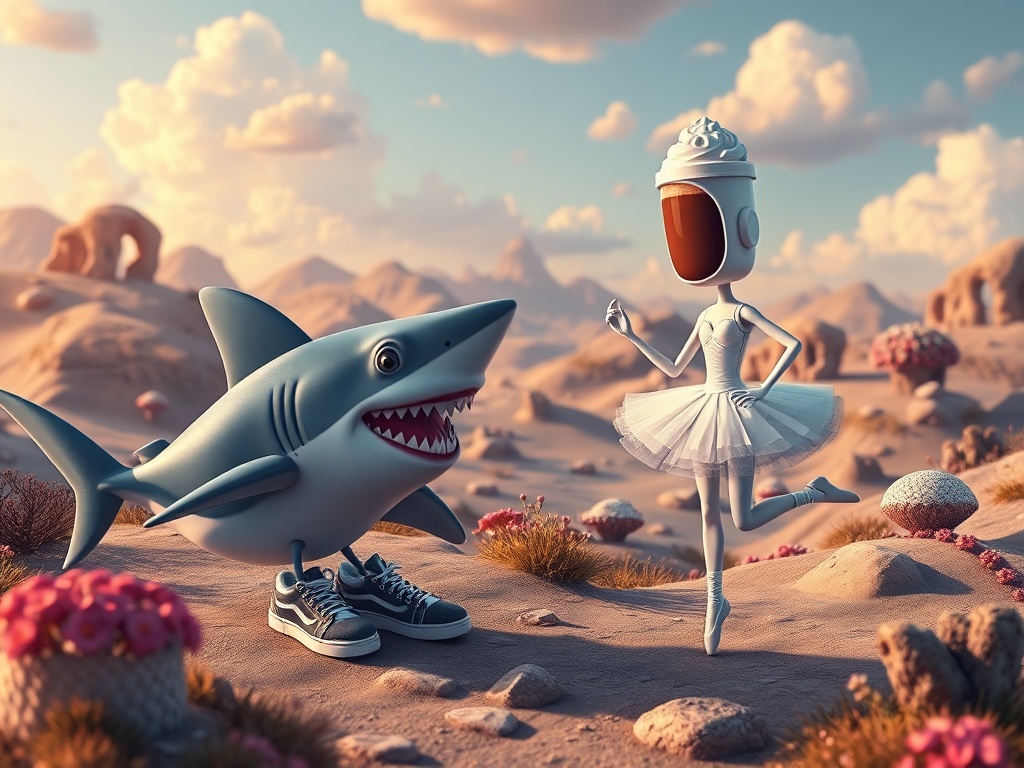OpenArt Unleashes Revolutionary AI Videos: Brainrot and Beyond
0
0

BitcoinWorld

OpenArt Unleashes Revolutionary AI Videos: Brainrot and Beyond
In the rapidly evolving digital landscape, the intersection of artificial intelligence and content creation is forging new frontiers. For those keenly observing the cryptocurrency and broader tech markets, the emergence of groundbreaking AI tools presents both immense opportunities and complex challenges. One such development capturing significant attention is the rise of AI-generated AI videos, particularly the viral phenomenon dubbed ‘brainrot’ videos. These captivating, often bizarre clips are redefining digital storytelling and user engagement, driven by innovative startups like OpenArt.
What are ‘Brainrot Videos’ and Why Are They Trending?
You’ve likely scrolled past them on your social media feeds: short, hyper-imaginative clips featuring characters like a shark in sneakers or a ballerina with a coffee cup for a head. These are the so-called ‘brainrot videos,’ a term coined to describe their often nonsensical yet strangely compelling nature. They are currently gaining significant traction, especially among younger users, due to their unique visual style and rapid production. What makes these brainrot videos so appealing is their ability to deliver a quick, often humorous, and visually striking narrative that stands out in a crowded content space.
The appeal lies in:
- Novelty: They offer something distinctly different from traditional video content.
- Ease of Consumption: Short, digestible formats perfect for platforms like TikTok.
- Creativity Unleashed: AI allows for character and scenario combinations previously unimaginable or too costly to produce.
This trend highlights a broader shift towards AI-assisted content creation, making it accessible to a wider audience than ever before.
OpenArt’s Revolutionary ‘One-Click Story’ Feature
At the forefront of this new wave is OpenArt, an AI startup founded in 2022 by two former Google employees. With approximately 3 million monthly active users, OpenArt is not just riding the trend; it’s actively shaping it. The company recently launched its highly anticipated ‘one-click story’ feature in open beta, a tool designed to drastically simplify video production.
This innovative feature allows users to:
- Input a single sentence, a script, or even an audio file like a song.
- Transform that input into a one-minute video complete with a coherent story arc.
The versatility of this tool is impressive. It can generate light-hearted stories ideal for TikTok, more serious explainer videos for YouTube, or even compelling music videos. OpenArt even envisions its application in advertising, offering a new avenue for brands to create dynamic, engaging content quickly. The ‘one-click story’ feature provides three distinct templates:
- Character Vlog: Users upload an image of their character and enter a prompt to guide the narrative.
- Music Video: The software analyzes uploaded songs, understands the lyrics, and generates animations that align with the song’s themes, such as illustrating flowers blooming in a garden for a nature-themed track.
- Explainer: Designed for educational or informational content, simplifying complex topics into engaging visual stories.
Users maintain creative control, able to edit individual clips by revisiting the editor’s storyboard mode and tweaking prompts for a more refined result. OpenArt’s platform stands out by aggregating over 50 different AI models, including popular ones like DALLE-3, GPT, Imagen, Flux Kontext, and Stable Diffusion, allowing users to choose their preferred tools for generation.
The Power of Generative AI in Video Creation
The core of OpenArt’s innovation lies in its masterful application of generative AI. This technology, which can produce new content from existing data, is democratizing video production by significantly lowering the barrier to entry for aspiring creators. Previously, creating animated or highly visual content required extensive skills in animation, graphic design, and video editing, along with expensive software and hardware.
With generative AI, the process is streamlined:
- Speed: Content that once took days or weeks can now be produced in minutes.
- Accessibility: Individuals without specialized technical skills can create professional-looking videos.
- Innovation: The ability to experiment with unique characters and narratives is greatly enhanced, leading to novel content forms like ‘brainrot’ videos.
This shift empowers a new generation of digital artists and content creators, fostering an environment where imagination is the primary limit, not technical proficiency or budget. The ability to quickly iterate and refine ideas means creators can adapt to trends and audience feedback at an unprecedented pace.
Navigating the Complexities: IP and Ethical Challenges for AI Videos
While the benefits of tools like OpenArt are clear—such as rapidly producing content with original characters and narratives—the landscape of AI videos is not without its controversies. The rapid advancement of generative AI has brought numerous ethical and legal issues to the forefront. These include concerns about:
- Imitating Artists’ Styles: AI models can learn and replicate the distinctive styles of human artists, raising questions about attribution and compensation.
- Intellectual Property (IP) Rights: The use of copyrighted characters or imagery in AI-generated content poses significant legal risks.
- Misuse and Misinformation: The ease of creating realistic but fabricated videos raises concerns about the spread of deepfakes and misinformation.
During testing, OpenArt acknowledged that its Character Vlog option might inadvertently venture into legally grey areas, particularly concerning characters like Pikachu, SpongeBob, and Super Mario. The potential for IP infringement is real, as evidenced by recent lawsuits, such as Disney and Universal suing AI firm Midjourney over AI-generated images. Users should be acutely aware that creating videos that infringe on copyright could lead to their content being removed from social media platforms. Furthermore, users found to have contributed to infringement could face legal action from copyright holders.
Coco Mao, co-founder and CEO of OpenArt, addressed these concerns, stating, “We try to be cautious around the IP infringement. When you upload some IP characters, by default, the models we use will reject them, and it’s not able to produce the IP character, but sometimes it slips.” Mao also expressed openness to discussing licensing agreements with major IP holders, indicating a proactive approach to these complex legal challenges.
OpenArt: A Promising AI Startup with Big Plans
What truly sets OpenArt apart in the crowded AI space is its commitment to character consistency. Unlike many average video models that produce simple, standalone clips users must manually piece together, OpenArt aims to ensure that both visuals and narrative remain cohesive throughout the video. “A problem that a lot of AI couldn’t really handle well is to have the character consistent in the same video…If you don’t have the same character, then it’s hard to get immersed in the story,” Mao explained. This focus on narrative immersion is a significant differentiator, making OpenArt’s outputs more compelling and professional.
Looking ahead, OpenArt has ambitious plans for its ‘one-click’ feature, including enabling users to create videos featuring conversations between two different characters. The development of a mobile application is also on their roadmap, promising even greater accessibility and convenience for creators on the go.
Financially, OpenArt operates on a credit-based system, offering several plans to cater to different user needs:
- Basic Plan: $14 per month for 4,000 credits, including up to 4 One-Click stories, 40 videos, 4,000 images, and 4 characters.
- Advanced Plan: $30 per month for 12,000 credits, including up to 12 One-Click stories.
- Infinite Plan: Priced at $56 per month for 24,000 credits.
- Team Plan: Available for $35 per month per member.
To date, OpenArt has successfully raised $5 million in funding from notable investors like Basis Set Ventures and DCM Ventures. The company boasts a positive cash flow and is on track to achieve an impressive annual revenue rate exceeding $20 million, signaling strong market adoption and financial health for this innovative AI startup.
OpenArt’s journey highlights the dynamic nature of AI innovation. By simplifying complex creative processes and addressing user needs for narrative consistency, OpenArt is not just creating ‘brainrot’ videos; it’s pioneering a new era of accessible, AI-powered storytelling. While the ethical and legal challenges surrounding AI-generated content remain, OpenArt’s proactive approach and commitment to continuous improvement position it as a key player in the future of digital media. For creators, marketers, and enthusiasts alike, understanding these developments is crucial as AI continues to reshape how we consume and produce content.
To learn more about the latest generative AI trends, explore our article on key developments shaping AI models features.
This post OpenArt Unleashes Revolutionary AI Videos: Brainrot and Beyond first appeared on BitcoinWorld and is written by Editorial Team
0
0
 Manage all your crypto, NFT and DeFi from one place
Manage all your crypto, NFT and DeFi from one placeSecurely connect the portfolio you’re using to start.




